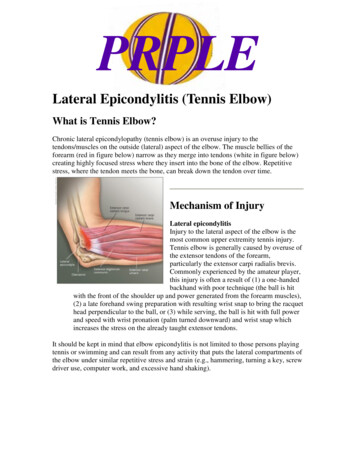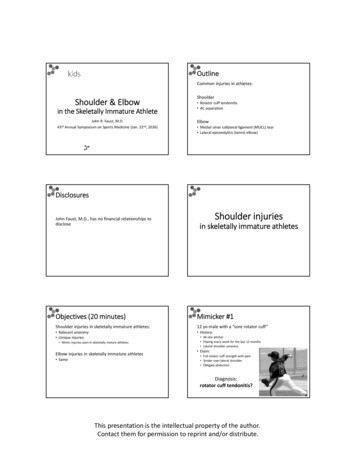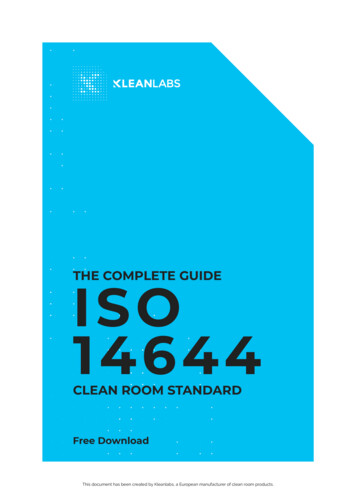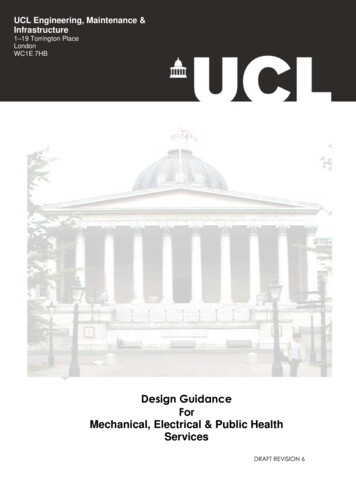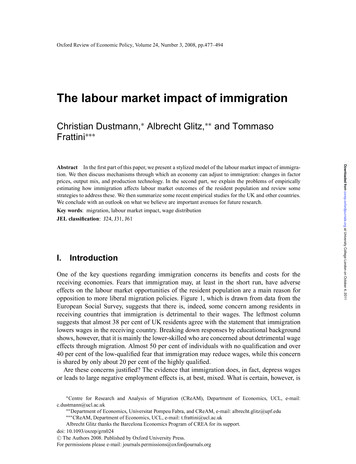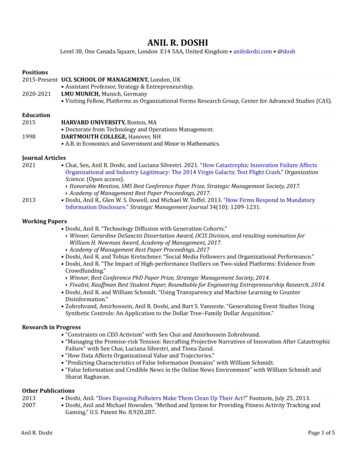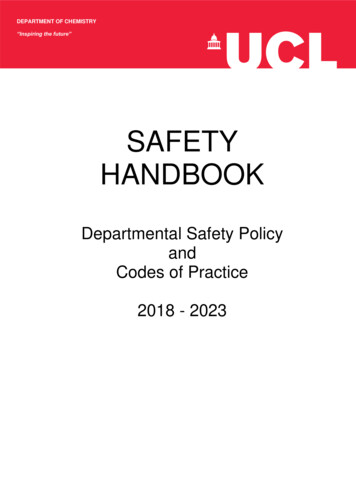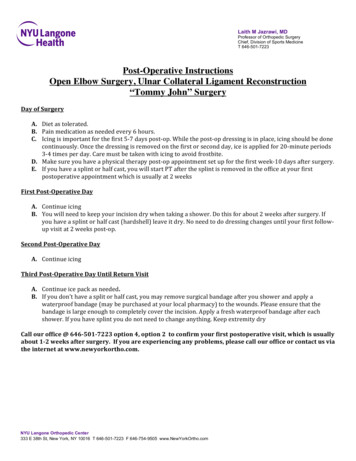
Transcription
Laith M Jazrawi, MDProfessor of Orthopedic SurgeryChief, Division of Sports MedicineT 646-501-7223Post-Operative InstructionsOpen Elbow Surgery, Ulnar Collateral Ligament Reconstruction“Tommy John” SurgeryDay of SurgeryA. Diet as tolerated.B. Pain medication as needed every 6 hours.C. Icing is important for the first 5-7 days post-op. While the post-op dressing is in place, icing should be donecontinuously. Once the dressing is removed on the first or second day, ice is applied for 20-minute periods3-4 times per day. Care must be taken with icing to avoid frostbite.D. Make sure you have a physical therapy post-op appointment set up for the first week-10 days after surgery.E. If you have a splint or half cast, you will start PT after the splint is removed in the office at your firstpostoperative appointment which is usually at 2 weeksFirst Post-Operative DayA. Continue icingB. You will need to keep your incision dry when taking a shower. Do this for about 2 weeks after surgery. Ifyou have a splint or half cast (hardshell) leave it dry. No need to do dressing changes until your first followup visit at 2 weeks post-op.Second Post-Operative DayA. Continue icingThird Post-Operative Day Until Return VisitA. Continue ice pack as needed.B. If you don’t have a split or half cast, you may remove surgical bandage after you shower and apply awaterproof bandage (may be purchased at your local pharmacy) to the wounds. Please ensure that thebandage is large enough to completely cover the incision. Apply a fresh waterproof bandage after eachshower. If you have splint you do not need to change anything. Keep extremity dryCall our office @ 646-501-7223 option 4, option 2 to confirm your first postoperative visit, which is usuallyabout 1-2 weeks after surgery. If you are experiencing any problems, please call our office or contact us viathe internet at www.newyorkortho.com.NYU Langone Orthopedic Center333 E 38th St, New York, NY 10016 T 646-501-7223 F 646-754-9505 www.NewYorkOrtho.com
Dr. Laith M. JazrawiChief, Division of Sports MedicineAssociate Professor Department of Orthopaedic SurgeryRehabilitation Protocol Following Ulnar Collateral LigamentReconstruc5on Using Autogenous Gra8The elbow is a complex system of three joints formed from three bones; the humerus (the upper arm bone), the ulna(the larger bone of the forearm, on the small finger side), and the radius (the smaller bone of the forearm onthe thumb side). This complex system allows a hinging ac?on (bending and straightening) and a rota?on ac?on. Thestability of the elbow joint is maintained by the bony congruency, the muscular a@achments and the ligaments.There are several important ligaments in the elbow. Ligaments are soC ?ssue structures that connect bones to bones.The ligaments around a joint usually combine together to form a joint capsule. A joint capsule is a water?ght sac thatsurrounds a joint and contains lubrica?ng fluid called synovial fluid. In the elbow, two of the most important ligaments arethe ulnar collateral ligament (UCL) and the lateral collateral ligament (LCL). The UCL is also known as the medial collateralligament. The UCL is on the medial (the side of the elbow that’s next to the body when your arms are at your side withyour palms up or facing out in front of you) side of the elbow and LCL is on the outside of your elbow. The ulnar collateralligament is a thick band of ?ssue that forms a triangular shape along the inside of the elbow. It has an anterior bundle,posterior bundle, and a thinner, transverse ligament. These ligaments can be torn when there is an injury or disloca?on ofthe elbow. If the injury to the ligament(s) affects the stability of the joint, it is possible that the func?on of the elbow willbe compromised. Injury to the UCL in overhead athletes has been widely reported. Normal ac?vi?es of daily living rarelyplace enough stress on the UCL to create instability; however throwing sports place high stresses on the elbow suppor?ngstructures. Over ?me, the high repe?ve stresses associated with throwing and overhead ac?vity may create overload tothe suppor?ng ligamentous support, resul?ng in a UCL tear. Typically, athletes with UCL injury report a history of repe?vethrowing with complaints of pain at the medial (inside) aspect of the elbow during or aCer their ac?vity. Onset occurs fromeither one trauma?c incident or can develop throughout a long period of ?me due to repe?ve elbow stress. Eventuallythe athlete loses their velocity and accuracy of throwing. More than 40% of athletes with UCL injury also report symptomsof ulnar nerve irrita?on from fric?on or snapping of the nerve during ac?vity.The overhead thrower oCen experiences pain with the arm fully cocked (shoulder in full external rota?on or the armrotated all the way back) and as it accelerates through the throw and release of the ball. While throwing,the elbow can straighten at speeds of over 2300 degrees per second and may have a valgus (side) force that exceeds theul?mate strength of the normal uninjured UCL. Therefore, proper mechanics and op?mal strength and endurance of themuscles of the upper extremity are needed to assist with injury preven?on. Trauma or injury to the UCL results insignificant func?onal limita?ons including medial elbow pain, loss of velocity and accuracy with throwing, instability,neurologic (nerve) symptoms, and decreased muscular strength.The consequences of this injury usually leave the athlete who has a torn UCL with two op?ons: 1) rehabilita?on withac?vity modifica?on (i.e. avoidance of pitching and performance throwing) or 2) surgical reconstruc?on with postopera?ve rehabilita?on prior to return to pitching and performance throwing.UCL reconstruc?on surgery is performed through an incision on the medial (inside) side of the elbow joint. The damagedulnar collateral ligament is replaced with a tendon taken from somewhere else in the body. The tendon graC can comefrom the pa?ent’s own forearm, hamstring, knee or foot. This is called an autograC. This tendon is weaved through drillholes in the humerus and ulna to re-create the triangular shape of the UCL.333 38th St. New York, NY 10016 (646) 501 7047 newyorkortho.com!
Rehabilitation Protocol After Elbow UCL ReconstructionOne common technique used to replace the damaged ulnar collateral ligament is called the dockingtechnique. The surgeon drills two holes in the ulna and three in the medial epicondyle of the humerus(the small bump of bone on the inside of the elbow at the bo@om of the upper arm). The two holes inthe ulna form a tunnel that the tendon graC will be looped through. The three holes in the medialepicondyle form a triangle. The bo@om hole will be bigger than the top two holes, so that the surgeoncan slide the end of the tendon graC into the bo@om hole. The two top holes are used to pull thetendon graC into the tunnel using sutures that are a@ached to the graC and threaded through the twoholes. ACer the tendon is harvested, sutures are a@ached to both ends. The tendon is looped throughthe lower tunnel formed in the ulna, and stretched across the elbow joint. The two sutures a@ached tothe ends of the graC are threaded into the larger bo@om tunnel in the medial epicondyle and each isthreaded out one of the upper, smaller holes. Using these two sutures, the surgeon pulls the end of thegraC farther into the upper tunnel un?l the amount of tension is correct to hold the joint in posi?on. Thesurgeon carefully puts the elbow through its full arc of mo?on and readjusts the tension on the suturesun?l sa?sfied that the proper ligamentous tension is restored. The two sutures are ?ed together to holdthe tendon graC in that posi?on.Another common technique to reconstruct the UCL is called the figure of eight technique. In thistechnique, the tendon graC is threaded through two pairs of holes - two drilled in the medial epicondyeof the humerus and two in the ulna. The graC is looped through the holes in a figure of eight fashion.The two ends of the tendon are sutured to the tendon itself.Previously the muscles on the inside of the elbow joint and forearm (the flexor muscles of the wrist)were completely detached from the humerus. Now, the flexor muscles are not detached, but are splitand retracted to allow the surgeon to see the areas of the elbow joint required to perform the opera?onsuccessfully. If there is any concern that the ulnar nerve has been stretched and damaged due to theinstability (as men?oned above), it may be re-routed so that it runs in front of the elbow joint ratherthan through the cubital tunnel in the back of the elbow. The incision is sutured together and the elbowis placed in a large bandage and splint.Rehabilita?on following surgical reconstruc?on of the UCL begins with range of mo?on and ini?alprotec?on of the reconstruc?on, along with resis?ve exercises to keep the shoulder and core strong.This is followed by progressions for resis?ve exercise that a@empt to fully restore strength and muscularendurance to allow for a safe return to throwing and overhead func?onal ac?vi?es. These guidelinesalso include aerobic training throughout the rehabilita?on process and, for many, a later stage aninterval throwing program. This mul?-faceted rehabilita?on approach oCen includes biomechanicalvideo analysis to ensure proper throwing mechanics before an athlete returns to their sport.The early phases of post-opera?ve care for UCL reconstruc?ons involve specific ?me frames,restric?ons and precau?ons to protect healing ?ssues and the surgical fixa?on/reconstruc?on. The laterphases of rehabilita?on are presented in a criterion based progression, where advancement tosubsequent levels is based on strength and control. Return to compe?ve throwing will take 8-12months. Not all athletes will be able to return to compe?ve throwing. The athlete should ice the elbowfor 15-20 minutes aCer their rehabilita?on program to help decrease pain and swelling.333 38th St. New York, NY 10016 (646) 501 7047 newyorkortho.com!
Rehabilitation Protocol After Elbow UCL ReconstructionPhase I (Surgery to 4 weeks after surgery)GoalsWeek 1ooooooooProtect healing tissueRetard muscle atrophyDecrease pain/inflammationPosterior splint at 90 elbow flexion for 7 daysBrace: application of functional brace set at 30-100 at day 7-10 after splintremovedROM: wrist AROM extension/flexionElbow compression dressing 2-3 daysExercises: gripping, passive wrist ROM, shoulder isometric (no shoulder ER),biceps isometrics, cryotherapyWeek 2ooooBrace: elbow ROM 25-100 in braceGradually increase ROM 5 extension and 10 flexion per weekExercises: continue all exercises listed aboveInitiate elbow extension isometricsWeek 3ooBrace: elbow ROM 15-110 Exercises: continue all exercises listed above, elbow ROM in brace, initiateactive ROM wrist and elbow (no resistance)Phase II (4 weeks to 7 weeks following surgery)GoalsWeek 4ooooooWeek 5Week 6Week 7oooooooGradual increase to full ROMPromote healing of repaired tissueRegain and improve muscular strengthBrace: elbow ROM 0-125 Exercises: begin light resistance exercises or arm (1 lbs), wrist curls,extensions, pronation, supination, elbow extension/flexionProgress shoulder program to emphasize rotator cuff strengthening,avoiding eternal rotation until week 6ROM: elbow ROM 0-135 D/C braceContinue all exercisesROM: 0-145 without brace or full ROMExercises: progress elbow strengthening exercises, initiate shoulder externalrotation strengtheningInitiate Thrower’s Ten ProgramProgress light isotonic program333 38th St. New York, NY 10016 (646) 501 7047 newyorkortho.com!
Rehabilitation Protocol After Elbow UCL ReconstructionPhase III (8 weeks to 13 weeks following surgery)GoalsWeeks 8-10oooooooImprove strength/power/enduranceMaintain full elbow ROMGradual return to functional activitiesExercises: initiate eccentric elbow flexion/extension,Continue isotonic program (forearm and wrist),Shoulder program (Thrower’s Ten),Stretching program (especially elbow extension)Phase IV (14 weeks to 32 weeks following surgery)GoalsoWeek 14oooWeek 16Weeks 22-24Week 30ooooContinue to increase strength, power and endurance of upper extremitymusculatureGradual return to activitiesExercises: continue strengthening program, emphasis on elbow and wriststrengthening and flexibility exercisesMaintain full elbow ROMExercises: initiate interval throwing program (Phase I), continue all exercisesStretch before and after throwingExercises: progress to Phase II Throwing Program (once Phase I complete)Exercises: progress to competitive throwingReferences333 38th St. New York, NY 10016 (646) 501 7047 newyorkortho.com!
Laith M Jazrawi, MDProfessor of Orthopedic SurgeryChief, Division of Sports MedicineT 646-501-7223Post Operative Rehabilitation Protocol Following Ulnar Collateral LigamentReconstruction Using Autogenous GraftName:Date:Diagnosis:Date of Surgery:Phase I –Immediate Post Operative Phase Goalso Protect healing tissueo Retard muscular atrophyo Decrease pain/inflammation Week 1o Posterior splint at 90 elbow flexion for 7 dayso Brace: application of functional brace set at 30-100 at day 7-10 after splint removedo ROM: wrist AROM ext/flexiono Elbow compression dressing 2-3 dayso Exercises§ Gripping§ Wrist ROM (passive only)§ Shoulder isometrics (no shoulder ER)§ Biceps isometrics§ Cryotherapy Week 2o Brace: Elbow ROM 25-100 in brace§ Gradually increase ROM 5 ext and 10 of flexion per weeko Exercises§ Continue all exercises listed above§ Elbow ROM in brace§ Initiate elbow extension isometrics Week 3o Brace: Elbow ROM 15-110 o Exercises§ Continue all exercises listed above§ Elbow ROM in brace§ Initiate active ROM wrist and elbow (no resistance)Phase II –Intermediate Phase (Week 4-7) Goalso Gradual increase to full ROMo Promote healing of repaired tissueo Regain and improve muscular strength Week 4o Brace: elbow ROM 0-125 NYU Langone Orthopedic Center333 E 38th St, New York, NY 10016 T 646-501-7223 F 646-754-9505 www.NewYorkOrtho.com
Laith M Jazrawi, MDProfessor of Orthopedic SurgeryChief, Division of Sports MedicineT 646-501-7223Exercises§ Begin light resistance exercises or arm (1 lbs)§ Wrist curls, extensions, pronation, supination§ Elbow ext/flexiono Progress shoulder program to emphasize rotator cuff strengthening§ Avoid external rotation until week 6Week 5o ROM: elbow ROM 0-135 o Discontinue braceo Continue all exercisesWeek 6o ROM: 0-145 without brace or full ROMo Exercises§ Progress elbow strengthening exercises§ Initiate shoulder external rotation strengtheningWeek 7o Initiate Thrower’s Ten Programo Progress light isotonic programo Phase III –Advanced Strengthening Program (Week 8-13) Goalso Improve strength/power/enduranceo Maintain full elbow ROMo Gradual return to functional activities Week 8-10o Exercises§ Initiate eccentric elbow flexion/extension§ Continue Isotonic program –forearm and wrist Shoulder program –Thrower’s Ten Stretching program –especially elbow extension Week 11-13o Exercises§ Continue all exercises listed above§ Initiate plyometric exercise programPhase IV –Return to Activity (week 14-32) Goalso Continue to increase strength, power, and endurance of upper extremity musculatureo Gradual return to activities Week 14o Exercises: continue strengthening program§ Emphasis on elbow and wrist strengthening and flexibility exercises§ Maintain full elbow ROMNYU Langone Orthopedic Center333 E 38th St, New York, NY 10016 T 646-501-7223 F 646-754-9505 www.NewYorkOrtho.com
Laith M Jazrawi, MDProfessor of Orthopedic SurgeryChief, Division of Sports MedicineT 646-501-7223 Week 16o Exercises§ Initiate interval throwing program (phase I)§ Continue all exercises§ Stretch before and after throwingWeek 22-24o Exercises§ Progress to Phase II Throwing Program (once completed Phase I)Week 30o Exercises§ Progress to competitive throwingComments:Frequency: times per weekDuration: weeksSignature:NYU Langone Orthopedic Center333 E 38th St, New York, NY 10016 T 646-501-7223 F 646-754-9505 www.NewYorkOrtho.comDate:
"Tommy John" Surgery Day of Surgery A. Diet as tolerated. B. Pain medication as needed every 6 hours. C. Icing is important for the first 5-7 days post-op. While the post-op dressing is in place, icing should be done continuously. Once the dressing is removed on the first or second day, ice is applied for 20-minute periods 3-4 times per day.

